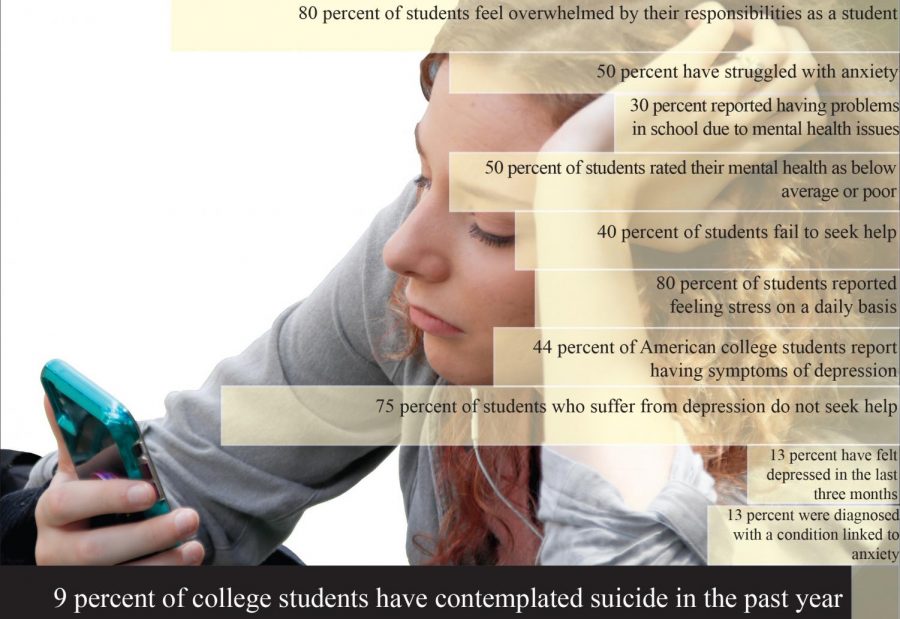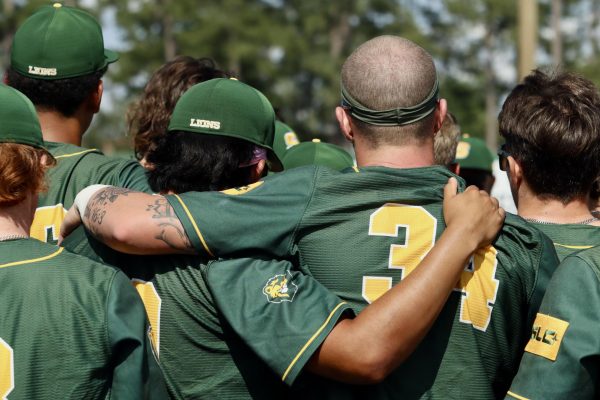Mental health affects college campuses
File Photo/The Lion’s Roar
Information in this graphic was gathered by the National Alliance on Mental Illness. It illustrates some of the mental health issues facing college students today including depression and anxiety .
Amidst the strain of exams and homework, many college students must also navigate anxiety, depression and other mental health issues.
According to the Substance Abuse and Mental Health Services Administration, while college students and their non-student peers share similar rates of mental illness, the added stressors of college life can trigger problems or exacerbate existing ones. A SAMHSA publication titled “Behavioral Health Among College Students Information & Resource Kit” acknowledged that increasingly more students already have a mental illness when they enroll in college.
An estimated nine percent of all full-time college students aged 18-22 had serious thoughts of suicide in 2017, according to the National Alliance on Metal Illness. NAMI also named anxiety disorders as the most common mental health concern in the United States.
Anxiety and depression are likely the most widely known mental illnesses. Each has subcategories of their own, but they are all part of an entire group of conditions. Eating disorders, obsessive-compulsive disorder, post-traumatic stress disorder and schizoaffective disorder also fall into the category of mental illness.
Annette Newton-Baldwin, counselor at the University Counseling Center, said it is possible for a person to experience more than one mental illness at a time.
“People can be dually diagnosed,” said Newton-Baldwin. “I can have anxiety and depression. I can have anxiety as part of my diagnosis of post-traumatic stress syndrome.”
Newton-Baldwin explained that conditions such as anxiety and depression may have multiple causes.
“There’s a big genetic argument, but there’s also intergenerational,” shared Newton-Baldwin. “It’s passed on through generations, through how we communicate, through how we shape our identities. If my great grandfather had trauma because he went to war, and he never really addressed that, and then he had kids, who had kids, then that anxiety and trauma is just carried on through the generations.”
Public opinion can create further challenges when identifying, diagnosing and treating mental illness.
“Our society still very much embraces this idea of ‘rugged individualism’ where we are supposed to be able to handle things without help,” stated Dr. June Williams, associate professor of counseling. “Many believe that seeking counseling
is a sign of weakness or perhaps think that they must have something extremely serious going on to seek help. I believe that we are slowly beginning to see a shift in some of this, but change takes time.”
As the long standing attitudes surrounding mental illness shift and the general population becomes more accepting, mental health professionals may face another obstacle.
“More people come to counseling than ever now here at the UCC,” shared Newton-Baldwin. “The only stigma that I ever hear nowadays is more people being accepting. They say, ‘Oh, my friend, that’s just the way he is.’ Then, they’re less likely to share their concern or intervene.”
This complacency minimizes the need for treatment and promotes the idea that people cannot change, said Newton-Baldwin.
Williams described other barriers patients may face after a diagnosis.
“From a systemic perspective, the long-term stigma about mental health issues is beginning to get better,” said Williams. “However, we are still fighting an uphill battle to obtain parity where mental health issues are considered as serious as physical illnesses. Because of this, the funding has always lagged behind in mental health treatment.”
The inadequate funding comes at a time when more college students are seeking out health care for mental illness on their own campuses. SAMHSA’s resource kit stated 11 percent of enrolled students sought counseling in 2014. Of those, 52 percent had serious psychological disorders.
The resource kit also noted that increased diversity could account for the jump in requests for service because minorities and marginalized groups face cultural tension and discrimination. Nontraditional students may incur the additional pressures of added financial stress, interrupted careers and life transitions.
The UCC offers 24/7 emergency services and covers issues including anxiety, depression, suicidal ideation, trauma, gender identity, abuse, eating disorders and academic impairment.
Your donation will support The Lion's Roar student journalists at Southeastern Louisiana University.
In addition, your contribution will allow us to cover our annual website hosting costs.
No gift is too small.






